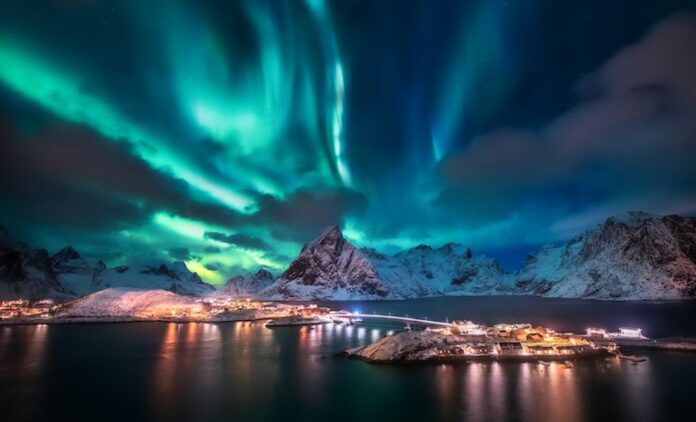Your guide to viewing the dancing lights in Vancouver, across the province, and just outside of B.C.
If you’ve spotted the northern lights in Vancouver, count yourself lucky.
While the sublime spectacle offers an unparalleled sky-watching opportunity, the city isn’t the best place to view the colourful manifestation. Unfortunately, light pollution in large cities makes the dancing lights difficult to observe.
But it isn’t impossible to catch the aurora borealis in action in Metro Vancouver skies. At the very least, you may have several decent opportunities to view them by travelling just outside of the city — and knowing how and where to look for them.
Vancouver Is Awesome spoke to University of British Columbia (UBC) Physics and Astronomy masters student Raelyn Sullivan about some viewing tips for observing the breathtaking display locally and abroad.
What are the aurora borealis?
While they look like luminant colours dancing in the night sky, the northern lights occur when charged particles (electrons and protons) from the sun collide with gases in Earth’s upper atmosphere. This interaction causes them to glow, which creates their trademark green hue.
“It’s a lot like a neon lamp in that way because it’s the same sort of physics there. Because our atmosphere has oxygen in it and it will glow green,” explained Sullivan.
At times, the Auroras may look like a milky, greyish cloud that is moving in the sky.
“The reason you typically don’t see the green light has more to do with the human eye. this is because when the human eye is not getting enough light in, it tends to see more in greys and shades of colour instead of getting the actual colour,” she described.
The northern lights actually come in a variety of colours, including blue and red.
Where do you have the best chance for viewing the northern lights?
Your best bet for viewing the dancing lights in all their celestial glory is in a destination closer to the North Magnetic Pole. Luckily, some of the best places for viewing them are here in Canada, including the Yukon.
Whitehorse is the largest city in the Yukon and home to several aurora borealis viewing lodges. Although they can’t guarantee that you’ll see a vivid astral display, your odds are quite high during peak season.
The aurora viewing season runs from late August to mid-April but the best time to view the lights is when the sky is at its absolute darkest. Keep in mind that the Yukon is a tad chilly in the heart of winter (temperatures may plummet down to the minus 40-degree range). Dress appropriately.
Some of the viewing lodges will allow you to rent clothing for the subzero temperatures, and some packages include it in the price. Furthermore, you can opt to use your cozy attire for other fun activities during the day in the frosty wonderland. Some of these include visiting hot springs, dog-sledding, wildlife watching, ice-fishing and much more.
A flight from Vancouver to Whitehorse is only about two hours long and costs roughly $350 CAD total with tax included direct with Air North. With that being said, you may want to book through a tour company that will include the price of your flights, accommodation, and activities in order to simplify the process.
How can you view the Northern Lights near Vancouver?
Since clear sky and darkness are both essential to see aurora, the best time is dictated by the weather and by the sunrise and sunset times.
The moon is also very bright and can make it more difficult to view the aurora, so lunar cycles should be taken into account.
You can follow the Canadian Space Agency’s aurora forecast to find out whether the northern lights will be visible in the sky near you.
Viewing the northern lights from a plane
If you are flying across Canada or B.C., there may be opportunities to view the lights from your vantage point.
“If you’re on an airplane and you’re travelling at night, and the track that you’re taking is passing over Northern regions, and that includes Canada…but even if you’re flying kind of cross Atlantic to Iceland or something like that…you’ve got pretty good odds that there is aurora in the sky,” Sullivan explains.
“Whether or not it’s super bright or not, it’s probably out there.”
In order to see them, however, there needs to be very little or no cloud cover and you need to be on the side of the plane that’s facing north.
The best time of day to spot them is “astronomical midnight,” or when the sun is exactly on the other side of the planet. At this time, the magnetic field lines are in the best position for viewing the display.
Of course, when you do spot them, they likely won’t appear green or any other colour. Instead, you’ll see the arcing, milky manifestation moving in the sky. In order to capture that green glow, you’ll need to use a camera with a longer exposure.
And while the aurora may seem like it is at the same height as you while you are flying, the perspective is grossly misleading; they are much higher in the sky and are quite large themselves.
While planes typically reach altitudes between six and eight km, the northern lights may dance between 97 to 1,000 km above the earth’s surface, according to National Geographic.
A Vancouver man recently shared a breathtaking perspective of the aurora borealis he snapped on a flight headed back to the city. He said he saw the dancing lights at “varying degrees, for well over an hour,” adding that it was “a surreal experience” trying to contain his excitement seeing them for the first time while surrounded by a couple of hundred people “who had no idea what was just outside the window.”










